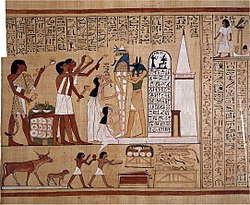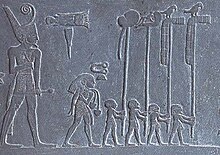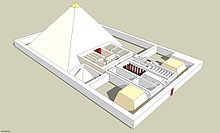Magic
The word "magic" is used to translate the Egyptian term heka, which meant, as James P. Allen puts it, "the ability to make things happen by indirect means". Heka was believed to be a natural phenomenon, the force which was used to create the universe and which the gods employed to work their will. Humans could also use it, however, and magical practices were closely intertwined with religion. In fact, even the regular rituals performed in temples were counted as magic. Individuals also frequently employed magical techniques for personal purposes. Although these ends could be harmful to other people, no form of magic was considered inimical in itself. Instead, magic was seen primarily as a way for humans to prevent or overcome negative events.
Magic was closely associated with the priesthood. Because temple libraries contained numerous magical texts, great magical knowledge was ascribed to the lector priests who studied these texts. These priests often worked outside their temples, hiring out their magical services to laymen. Other professions also commonly employed magic as part of their work, including doctors, scorpion-charmers, and makers of magical amulets. It is also likely that the peasantry used simple magic for their own purposes, but because this magical knowledge would have been passed down orally, there is limited evidence of it.
Language was closely linked with heka, to such a degree that Thoth, the god of writing, was sometimes said to be the inventor of heka. Therefore, magic frequently involved written or spoken incantations, although these were usually accompanied by ritual actions. Often these rituals invoked the power of an appropriate deity to perform the desired action, using the power of heka to compel it to act. Sometimes this entailed casting the practitioner or subject of a ritual in the role of a character in mythology, thus inducing the god to act toward that person as it had in the myth. Rituals also employed sympathetic magic, using objects believed to have a magically significant resemblance to the subject of the rite. The Egyptians also commonly used objects believed to be imbued with heka of their own, such as the magically protective amulets worn in great numbers by ordinary Egyptians.
Funerary practices
Because it was considered necessary for the survival of the soul, preservation of the body was a central part of Egyptian funerary practices. Originally the Egyptians buried their dead in the desert, where the arid conditions mummified the body naturally. In the Early Dynastic Period, however, they began using tombs for greater protection, and the body was insulated from the desiccating effect of the sand and was subject to natural decay. Thus the Egyptians developed their elaborate embalming practices, in which the corpse was artificially desiccated and wrapped to be placed in its coffin. The quality of the process varied according to cost, however, and those who could not afford it were still buried in desert graves.
Once the mummification process was complete, the mummy was carried from the deceased person's house to the tomb in a funeral procession that included his or her friends and relatives, along with a variety of priests. Before the burial, these priests performed several rituals, including the Opening of the mouth ceremony intended to restore the dead person's senses and give him or her the ability to receive offerings. Then the mummy was buried and the tomb sealed Afterward, relatives or hired priests gave food offerings to the deceased in a nearby mortuary chapel at regular intervals. Over time, families inevitably neglected offerings to long-dead relatives, so most mortuary cults only lasted one or two generations. However, while the cult lasted, the living sometimes wrote letters asking deceased relatives for help, in the belief that the dead could affect the world of the living as the gods did.
The first Egyptian tombs were mastabas, rectangular brick structures where kings and nobles were entombed. Each of them contained a subterranean burial chamber and a separate, aboveground chapel for mortuary rituals. In the Old Kingdom the mastaba developed into the pyramid, which symbolized the primeval mound of Egyptian myth. Pyramids were reserved for royalty, and were accompanied by large mortuary temples sitting at their base. Middle Kingdom pharaohs continued to build pyramids, but the popularity of mastabas waned. Increasingly, commoners with sufficient means were buried in rock-cut tombs with separate mortuary chapels nearby, an approach which was less vulnerable to tomb robbery. By the beginning of the New Kingdom even the pharaohs were buried in such tombs, and they continued to be used until the decline of the religion itself.
Tombs could contain a great variety of other items, including statues of the deceased to serve as substitutes for the body in case it was damaged. Because it was believed that the deceased would have to do work in the afterlife, just as in life, burials often included small models of humans to do work in place of the deceased.The tombs of wealthier individuals could also contain furniture, clothing, and other everyday objects intended for use in the afterlife, along with amulets and other items intended to provide magical protection against the hazards of the spirit world. Further protection was provided by funerary texts included in the burial. The tomb walls also bore artwork, including images of the deceased eating food which were believed to allow him or her to magically receive sustenance even after the mortuary offerings had ceased.
History
Predynastic and Early Dynastic periods
The beginnings of Egyptian religion extend into prehistory, and evidence for them comes only from the sparse and ambiguous archaeological record. Careful burials during the Predynastic period imply that the people of this time believed in some form of an afterlife. At the same time, animals were ritually buried, a practice which may reflect the development of zoomorphic deities like those found in the later religion. The evidence is less clear for gods in human form, and this type of deity may have emerged more slowly than those in animal shape. Each region of Egypt originally had its own patron deity, but it is likely that as these small communities conquered or absorbed each other, the god of the defeated area was either incorporated into the other god's mythology or entirely subsumed by it. This resulted in a complex pantheon in which some deities remained only locally important while others developed more universal significance. As the time changed and the shifting of the empires changed like the middle kingdom, new kingdom, and old kingdom, usually the religion followed stayed within the border of that territory.
The Early Dynastic period began with the unification of Egypt around 3000 BC. This event transformed Egyptian religion, as some deities rose to national importance and the cult of the divine pharaoh became the central focus of religious activity. Horus was identified with the king, and his cult center in the Upper Egyptian city of Nekhen was among the most important religious sites of the period. Another important center was Abydos, where the early rulers built large funerary complexes.
Old and Middle Kingdoms
During the Old Kingdom, the priesthoods of the major deities attempted to organize the complicated national pantheon into groups linked by their mythology and worshipped in a single cult center, such as the Ennead of Heliopolis which linked important deities such as Atum, Ra, Osiris, and Set in a single creation myth. Meanwhile, pyramids, accompanied by large mortuary temple complexes, replaced mastabas as the tombs of pharaohs. In contrast with the great size of the pyramid complexes, temples to gods remained comparatively small, suggesting that official religion in this period emphasized the cult of the divine king more than the direct worship of deities. The funerary rituals and architecture of this time greatly influenced the more elaborate temples and rituals used in worshipping the gods in later periods.
Early in the Old Kingdom, Ra grew in influence, and his cult center at Heliopolis became the nation's most important religious site. By the Fifth Dynasty, Ra was the most prominent god in Egypt, and had developed the close links with kingship and the afterlife that he retained for the rest of Egyptian history. Around the same time, Osiris became an important afterlife deity. The Pyramid Texts, first written at this time, reflect the prominence of the solar and Osirian concepts of the afterlife, although they also contain remnants of much older traditions. Therefore the texts are an extremely important source for understanding early Egyptian theology.
In the 22nd century BC, the Old Kingdom collapsed into the disorder of the First Intermediate Period, with important consequences for Egyptian religion. Old Kingdom officials had already begun to adopt the funerary rites originally reserved for royalty, but now, less rigid barriers between social classes meant that these practices and the accompanying beliefs gradually extended to all Egyptians, a process called the "democratization of the afterlife".The Osirian view of the afterlife had the greatest appeal to commoners, and thus Osiris became one of the most important gods.
Eventually rulers from Thebes reunified the Egyptian nation in the Middle Kingdom (c. 2055–1650 BC). These Theban pharaohs initially promoted their patron god Monthu to national importance, but during the Middle Kingdom he was eclipsed by the rising popularity of Amun. In this new Egyptian state, personal piety grew more important and was expressed more freely in writing, a trend which continued in the New Kingdom.
New Kingdom
The Middle Kingdom crumbled in the Second Intermediate Period (c. 1650–1550 BC), but the country was again reunited by Theban rulers, who became the first pharaohs of the New Kingdom. Under the new regime, Amun became the supreme state god. He was syncretized with Ra, the long-established patron of kingship, and his temple at Karnak in Thebes became Egypt's most important religious center. Amun's elevation was partly due to the great importance of Thebes, but it was also due to the increasingly professional priesthood. Their sophisticated theological discussion produced detailed descriptions of Amun's universal power.
Increased contact with outside peoples in this period led to the adoption of many Near Eastern deities into the pantheon. At the same time, the subjugated Nubians absorbed Egyptian religious beliefs, and in particular, adopted Amun as their own.
The New Kingdom religious order was disrupted when Akhenaten acceded, and replaced Amun with the Aten as the state god. Eventually he eliminated the official worship of most other gods, and moved Egypt's capital to a new city at Amarna, for which this part of Egyptian history, the Amarna period, is named. In doing so Akhenaten claimed unprecedented status for himself: only he could worship the Aten, and the populace directed their worship toward him. The Atenist system lacked well-developed mythology and afterlife beliefs, and the Aten itself seemed distant and impersonal, so the new order did not appeal to ordinary Egyptians. Thus, many of them probably continued to worship the traditional gods in private. Nevertheless, the withdrawal of state support for the other deities severely disrupted Egyptian society. Akhenaten's successors therefore restored the traditional religious system, and eventually they dismantled all Atenist monuments.
Before the Amarna period, popular religion had trended toward more personal relationships between the gods and their worshippers. Akhenaten's changes had reversed this trend, but once the traditional religion was restored, there was a backlash. The populace began to believe that the gods were much more directly involved in daily life. Amun, the supreme god, was increasingly seen as the final arbiter of human destiny, the true ruler of Egypt. The pharaoh was correspondingly more human and less divine. The importance of oracles as a means of decision-making grew, as did the wealth and influence of the oracles' interpreters, the priesthood. These trends undermined the traditional structure of society and contributed to the breakdown of the New Kingdom.
Later periods
In the 1st millennium BC, Egypt was significantly weaker than in earlier times, and in several periods foreigners seized the country and assumed the position of pharaoh. The importance of the pharaoh continued to decline, and the emphasis on popular piety continued to increase. Animal cults, a characteristically Egyptian form of worship, became increasingly popular in this period, possibly as a response to the uncertainty and foreign influence of the time. Isis grew more popular as a goddess of protection, magic, and personal salvation, and became the most important goddess in Egypt.
In the 4th century BC, Egypt became a Hellenistic kingdom under the Ptolemaic dynasty (305–30 BC), which assumed the pharaonic role, maintaining the traditional religion and building or rebuilding many temples. The kingdom's Greek ruling class identified the Egyptian deities with their own. From this cross-cultural syncretism emerged Serapis, a god who combined Osiris and Apis with characteristics of Greek deities, and who became very popular among the Greek population. Nevertheless, for the most part the two belief systems remained separate, and the Egyptian deities remained Egyptian.
Ptolemaic-era beliefs changed little after Egypt became a province of the Roman Empire in 30 BC, with the Ptolemaic kings replaced by distant emperors. The cult of Isis appealed even to Greeks and Romans outside Egypt, and in Hellenized form it spread across the empire. In Egypt itself, as the empire weakened, official temples fell into decay, and without their centralizing influence religious practice became fragmented and localized. Meanwhile, Christianity spread across Egypt, and in the third and fourth centuries AD, edicts by Christian emperors and iconoclasm by local Christians eroded traditional beliefs. While it persisted among the populace for some time, Egyptian religion slowly faded away.
Legacy
Egyptian religion produced the temples and tombs which are ancient Egypt's most enduring monuments, but it also left many influences on other cultures. In pharaonic times many of its symbols, such as the sphinx and winged solar disk, spread widely across the Mediterranean and Near East, as did some of its deities, such as Bes. Some of these connections are difficult to trace. The Greek concept of Elysium may have derived from the Egyptian vision of the afterlife. In late antiquity, the Christian conception of Hell was most likely influenced by some of the imagery of the Duat, and the iconography of Mary may have been influenced by that of Isis. Egyptian beliefs also influenced or gave rise to several esoteric belief systems developed by Greeks and Romans who saw Egypt as a source of mystic wisdom. Hermeticism, for instance, derived from the tradition of secret magical knowledge associated with Thoth.
Traces of ancient beliefs remained in Egyptian folk traditions into modern times, but its impact on modern societies greatly increased with the French Campaign in Egypt and Syria in 1798. As a result of it, Westerners began to study Egyptian beliefs firsthand, and Egyptian religious motifs were adopted into Western art. Egyptian religion has since had a significant impact on popular culture. Due to continued interest in Egyptian belief, in the late 20th century several new religious groups form





